Tuesday, November 29, 2011
Sea Kayak Rescues
Our little viewing group ended up with quite a divided opinion.There's no question that the photography is excellent, but as an instructional DVD some of us thought that there was very little instruction to speak of, and that it was more of a demonstration DVD rather than an instructional DVD; after very brief and simplified descriptions of rescue techniques on flat water, we're quickly shown the rescues in more challenging water. Experienced kayakers may appreciate and understand the skills on display, but some of us were dubious that a beginner would understand the nuances of the skills presented without more in-depth explanation of the steps and manoeuvres involved. Some of our group did find the instruction technique effective, and Leon and Shawna are effective compelling presences on the screen, but some of us felt we'd just watched a trailer for a great DVD and were left hanging waiting for the real DVD to actually start. These criticisms don't take away from the fact that it is marvellously photographed and the rough water sequences are thrilling to watch. And it can't hurt to watch new examples of rescue techniques in action.
If you like watching kayaks in crazy conditions, this will be right up your alley, but as a learning aid your mileage may vary.
Sunday, November 27, 2011
Respite
Our normally sandy beach was covered with driftwood that had piled up over the last few days.

Down the beach a ways we noticed that a couple of ships anchored near the yacht club had broken lose and were on the beach.

At least they had better luck than the owner of this boat....

...which is now not much more than kindling and matchsticks.
There were some sail boats out, and we even saw a few kayakers heading out, probably to go play in Baynes Channel.

Finally Bernie found what he was looking for -- the remains of a sail boat that came ashore a few days ago.

Followed ashore by the driftwood, the boat was smashed to bits by the relentless pounding of the waves and the wood. Only the mast and a sink was recoverable. The rest was broken dreams and splinters.
Friday, November 25, 2011
Brinicle Video
Also have to be home when Bernie gets back from the Rainbow Kitchen, so I can help him carry up the hill to University House 2 the cannoli lunch he's made.
Since I can't spend an hour out on the water, I won't pout. I checked out a video my cousin found on the internet -- a video of a brine icicle forming under sea ice. It's been nicknamed a "brinicle."
Y'see, when there's particularly cold air over sea water, like -20 degrees C over water hovering near the freezing point, sometimes a draft of warmish water rises. It freezes at the surface, and the dense, saltier water left behind sinks from the new ice in a column of cold water. It looks like a stalactite or an icicle growing downward from the sea ice at the surface. And if it reaches the sea bottom, the ice freezes, trapping any living thing on the bottom at that spot.
As well, you can read a little more about the science of seawater circulation in the Arctic by reading a profile I wrote on oceanographer Dr Chris Garrett. It's on-line at the Science.ca website, along with many other profiles on Canadian scientists.
Thursday, November 24, 2011
More Books, Less Paddling
Managed to get the dogs back to the Beach House without having to shampoo salt water out of their fur. And I've found time this morning before going to the special collections room at the public library to study, so here's a brief note about some more books I've read recently that might interest paddlers.
Philip Teece is a local writer with several good books worth finding on the library shelves. Raincoast Macabre is a collection of his west coast ghost stories -- very chill. Plenty of kayaking references in these stories, as well as other small boats.
His book A Dream of Islands has several stories detailing how he constructed and became familiar with his little sailboat Galadriel. It's of particular interest to anyone jonesing to build their own wooden boat! Most of all, I enjoy the references to local islands and bays around the Saanich Peninsula.
 Follow the further adventures of the sailboat Galadriel in Teece's book A Shimmer on the Horizon. Here Teece tells of taking his little boat beyond Desolation Sound with a new partner in her own sailboat. Gunkholing from one anchorage to another sounds like a marvelous way to spend a summer.
Follow the further adventures of the sailboat Galadriel in Teece's book A Shimmer on the Horizon. Here Teece tells of taking his little boat beyond Desolation Sound with a new partner in her own sailboat. Gunkholing from one anchorage to another sounds like a marvelous way to spend a summer. All three of these titles were released by the Victoria-based publisher Orca Book Publishers. Some of Teece's books are still available in bookstores, and these three titles are all in the Greater Victoria Public Library. Check 'em out and do a little armchair sailing and paddling this stormy winter!
All three of these titles were released by the Victoria-based publisher Orca Book Publishers. Some of Teece's books are still available in bookstores, and these three titles are all in the Greater Victoria Public Library. Check 'em out and do a little armchair sailing and paddling this stormy winter!
Wednesday, November 23, 2011
From the Octopus's Viewpoint
And while we're in an octopus mood, check out this clip of an octopus walking on dry land:
Tuesday, November 22, 2011
A Bit of Fluff
Then I thought a little more about that bit of fluff. Probably from my clothes. I bought new socks the other day, so that fluff might be from a sock. Polyester.
Polyester might not seem like something to write about in a kayaking blog. But if you've read the news on Science Daily, you'll know that clothing is a source of tiny particles of plastic that can be found in sea water. Go to this link and see the article.
Basically, tiny bits of polyester and acrylic are breaking off clothing in washing machines. The water draining out of washing machines ends up in the ocean. Shorelines tested all over the world show microplastic debris on the beaches and in the guts of marine life.
One speck in a microbial life form isn't too much. But the microplastic doesn't digest, and it accumulates in the food chain.
Scientist Mark Browne and his colleagues wrote a report saying that "more than 1,900 fibers can rinse off of a single garment during a wash cycle, and these fibers look just like the microplastic debris on shorelines." The report calls for designers of washing machines "to develop methods for removing microplastic from sewage."
I don't know how guilty I can feel about fibers wearing off my clothing and sludging into the wastewater pipes. Guilty enough that I am going to make the effort to buy natural fiber clothes when I can, and that means no more cheap polyester socks. I already knew that I like the feel of wool, silk, and cotton, as well as other natural fibers. I already knew that merino wool clothes are better for paddling than polyester!
Monday, November 21, 2011
One Thing
Pulled my parka on and walked the landlady's dogs. In my neighbourhood it's okay to wear pyjamas while walking dogs, especially if the pjs kinda look like yoga gear instead of being the flannel type with Snoopy dog patterns.
While walking dogs I saw the weather was great for November -- cold but no wind or rain. Yay! So you can bet that ten minutes later I was walking through the park again, but this time without dogs and with a rec kayak on my shoulder.
It's been windy too many days lately! We've been making do with kayaking videos instead of going out in the boats. High tide and slack current made it a great day to be on the water.
So nice to go out and do the loop along the beach, along the rocky shore, then out and around Flower Island and back. There were gaps in the cloud cover, and the sun glared down, bright but not hot. It was wonderful to see the water all clear again! In summer, the bay's water grows cloudy. Now, I could even see white sea anemones on the rocks underwater at the rocky shoreline. I turned and swirled, practising some of the extended-reach moves shown in the kayaking videos. Cormorants took off and gave me some room to move.
There were otters tumbling inside the line of bull kelp, so I paddled outside the tangles and managed not to disturb them too. The otters are good neighbours, as far as I can tell. The one that galloped through our front yard this summer was a big friendly fella.
Birds galore floated or flew past. It always amazes me how ducks' wings whistle as they take off or land. Even those little ducky birds called surf scoters. I made note of the black and white wings of one little flock of birds, to look up in bird books.
As I rounded Flower, I went to Evans Rock. Looking one way, there was Mount Rainier, dim but showing through the patchy clouds. Looking another, there was Mount Baker, bright with fresh snow. It was a two-volcano day! So I pressed the OK button on my SPOT and sent a message with a link showing my location.
The air was so clean. There wasn't any current in the little channel as I paddled past the rock that looks like a crouching cat. "Just give me one thing I can hold onto/ to believe in..." really gotta learn all the words to that song.
An eagle soared past, and a kingfisher darted by. There's a coffee shop in the neighbourhood, and up high on one of the walls is written:
Hopping out of bed and thinking about the one thing
Then a splash distracted me. The otters were still tumbling inside the line of bull kelp along the shore. I guessed there must still be herring or some other schools of fish gathering in that place. Trying to give them lots of room, I headed farther off-shore, but the otters came up in front of me and ducked down again. One popped up again, close enough that I could see the fish caught in his jaws. Way to go, otter!
Back along the shore, avoiding dogs swimming for tennis balls. Then back to the Beach House with the kayak on my shoulder. Made medlar jelly, and sealed it in mason jars. Wrote and wrote while the wind picked up as the day ended. What a day!
Thursday, November 17, 2011
But Where's My Jet Pack and Auto-Gyro?

Monday, November 14, 2011
Commando Kayaking in Winter
 John and Louise took their car with their Delta sea kayaks on top. Alison rode in her own car that's currently being driven by her parents, with her Wilderness Systems Kestrel rec kayak on top. (Shorter than the Deltas, it's a good fit on her smaller sedan. Here's a photo that John took last year at Gyro Park, showing the Kestrel on the sedan.) The Sinclairs waved at their madcap daughter and headed back home to hot tea and scones, I'm guessing, since they had no interest in hanging around the chill beach. I hopped on the bus a block from the Beach House, transferred downtown, and hopped off the jitney (or le car in French) at Six Mile House.
John and Louise took their car with their Delta sea kayaks on top. Alison rode in her own car that's currently being driven by her parents, with her Wilderness Systems Kestrel rec kayak on top. (Shorter than the Deltas, it's a good fit on her smaller sedan. Here's a photo that John took last year at Gyro Park, showing the Kestrel on the sedan.) The Sinclairs waved at their madcap daughter and headed back home to hot tea and scones, I'm guessing, since they had no interest in hanging around the chill beach. I hopped on the bus a block from the Beach House, transferred downtown, and hopped off the jitney (or le car in French) at Six Mile House.Yeah, yeah, so who uses "jitney" for the bus linking a satellite community to an urban core? Or "le car" for that matter? Someone who just read an article about Alzheimer's disease, that's who. Apparently people suffering from Alzheimer's who are bilingual can have up to twice as much brain damage as people who show a similar amount of visible signs and symptoms but are not bilingual. In the interest of making my nearly-bilingual brain more resilient in case I'm ever faced with Alzheimer's disease, I'm incorporating vocabulary from French and from other dialects of English into my daily discourse, eh? D'accord?
Bilingual observations aside, commando kayaking in winter is less fun than in summer. While it didn't rain during my commute, there were other issues. I arrived at the bus stop ten minutes early for the first run of that Sunday morning, but the bus arrived ten minutes late. So I got downtown too late for the #50 bus and had to wait. Once I finally got to Six Mile House, it's a fair walk over two little hills to the lake. Luckily, a passer-by alerted me when the ball of yarn from my knitting fell out of my pocket. It was unrolling along behind me on the sidewalk, but my knitting hadn't yet begun to unravel -- whew!
Meanwhile, John, Louise, and Alison had already arrived at Thetis Lake. They paddled from our usual launch spot at the second beach, around a point and up to the first beach as we arranged. I was not yet there. If you check out John's post, you can see his drawing of the route he took that morning. It shows that he and Louise and Alison went around in circles for a while, back to a nearby island and back to the beach when they saw me crest the hill and plod down to the beach.
We still had fun. We noodled all over the lake. And it didn't matter a bit whether the wind came up or there were a few raindrops, or more chill than we prefer. The lake is sheltered. That's part of why we paddle lakes in the winter -- so we don't have the disappointment of going all the way to an ocean bay that surprises us by being full of rough waves and wind from an unexpected direction.
After paddling, we stuffed my Expedition into the back seat of Louise & John's car and me into the back seat of Alison's sedan (with her parents staring admiringly as the hardshell kayaks were loaded onto the roof racks of both vehicles). Then we retraced my portage from the bus stop to Six Mile House.
Alas, the pub restaurant serves only buffet luncheon until 2pm on Sundays. A fine buffet, but one for people with grand appetites, not those who just wanted soup and tea. So we went our separate ways. I bid goodbye to the rest there, thanking them for saving me the portage, and hot-footed it a long block to the bus stop, where the driver waited for me to trot the last fifty yards to le car with my kayak. Yay! Merci! Much nicer than waiting 45 minutes for the next scheduled bus to arrive.
The ride and the transfer gave me a chance to knit another few rounds on the latest pair of fingerless mitts for a colleague of Louise's at UVic. Some of us have always felt it's better to wrap the humans up in warm clothes than to turn up the thermostat in winter. These mitts may look like frivolous decorations compared with neoprene kayaking gloves, but I gotta say, if those people in Records and Admissions want to keep warm, I will keep knitting for them!
Friday, November 11, 2011
Blow Hard

The remains of that big storm that slammed into Alaska a few days ago made its way down the coast and slammed into us today. A morning of torrential rain was followed by an afternoon wind storm. 40kmh winds with gusts into the the 70s.
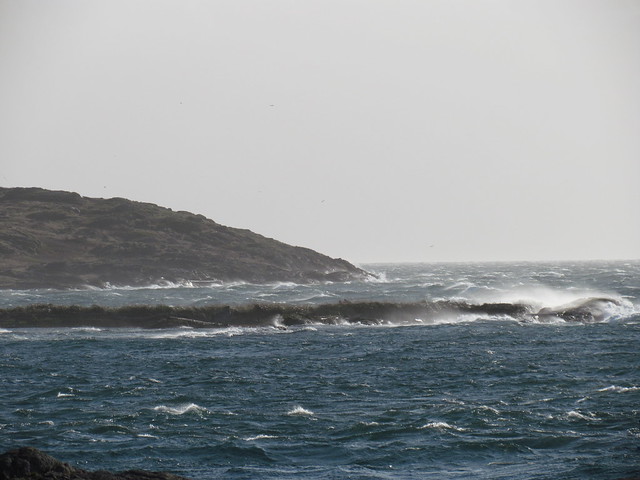
With the breeze forecast to keep up all weekend, it's not likely that we're going to hit the water...
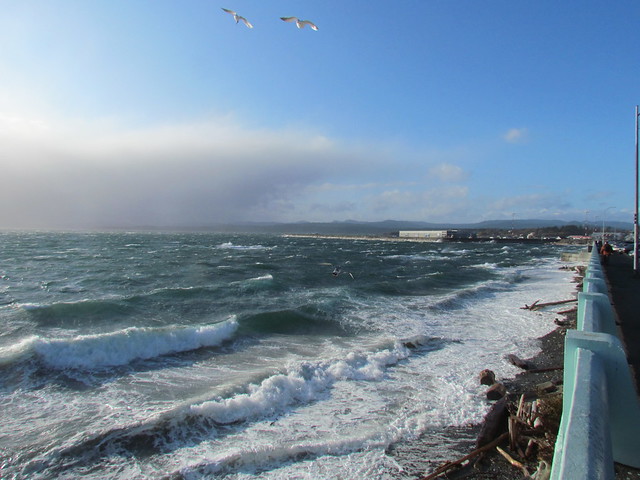
...which is a real shame because we want to paddle into the Oak Bay Marina and check out this personal hovercraft.
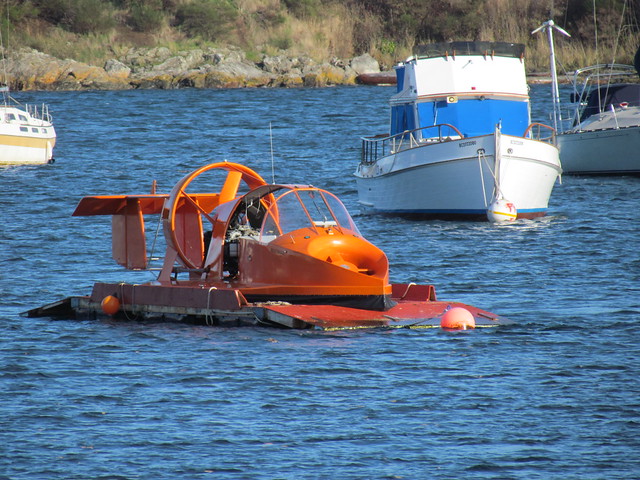
Thursday, November 10, 2011
Local Kayaker Wins!
This wasn't just some morning paddle with a couple of buddies. At this festival, there were demonstrations and workshops instructed by two of the most celebrated Greenland-style paddlers in the world. If you don't know who Maligiaq Padilla or Dubside is, well friend, you don't paddle stick. Helen Wilson and Jeanette Rogers instructed as well. Check out Helen's post about the Festival at her terrific website.
Check out the official results at Kayak Academy's website. Mike competed and took third in the "Harpoon Throwing From Kayak for Distance" Category and also third for rolling! That put him solidly in third place for "Overall Combined Kayak Champion." Way to go, Mike!
He also took first place in the demonstration event for accuracy throwing a harpoon... wonder where he got all the practise...
Check out Mike Jackson's blog for his own notes on the event. You'll need to scroll down a little to his post for Oct29-30. Since then, the man's already been to -- get this! -- Surge Narrows. And posted a note on his website about the trip. Wow.
Monday, November 07, 2011
E.T. Seton's The Arctic Prairies
Born in 1860 in South Shields, UK to Scots Loyalist parents, Ernest Evan Thompson emigrated to Canada with his parents and nine brothers when he was six years old. When he was young, he avoided his father by retreating to the woods, studying and drawing animals. A scholarship in art brought him to the Royal Academy in London, England for a couple of years. Rejecting his father, the young man changed his name to Ernest Thompson Seton, as he felt that Seton had been an important name in his father's family tree.
Drawing the natural world became not only a personal passion for Seton, but his career as he failed at farming with his brother and with friends. He was appointed the Provincial Naturalist for the province of Manitoba, and created reference works on birds and animals that are still used today. Of the 42 books that Seton wrote, his 1898 book Wild Animals I Have Known is the most acclaimed. Rudyard Kipling told Seton in a letter that he got the idea to write the Jungle Books from reading Wild Animals I have Known.
In 1907, Seton set out on a canoe trip exploring Hudson's Bay Company routes in Canada's Northwest Territory, in the areas of Athabaska River, Salt River and Thelon River. The trip lasted seven months and covered some 2,000 miles. His notes became the book The Arctic Prairies. Soon after he returned, he was elected to the Explorers Club, which included only the most celebrated adventurers like Sir Edmund Hillary and Admiral Peary.
His Own Agenda
Unlike the explorers that he admired, Seton set off on his journey simply because he wanted to. He was not appointed by the British or Canadian government nor hired by a fur trading company, though as he acknowledged, a trip of this kind simply could not have been made into Canada's Northwest Territory in 1907 without the co-operation of the Hudson's Bay Company. He paid all his own expenses and some expenses for his companion, the natural biologist Edward Alexander Preble. In his book The Arctic Prairies, Seton writes as if the younger man were his assistant, but in fact Preble was conducting his own research.
Though some of the words Seton uses in The Arctic Prairies are no longer polite idiom, they were not used as hate words by Seton. He uses the words "Indian" and "White" as if they had no more nasty connotation than calling casually someone "French" or "Scot." Seton admired many men among the First Nations, and did not hesitate to condemn men of European or First Nations descent who were lazy or venal.
Seton's sense of humour shows in wry anecdotes throughout the text, often at someone else's expense. "'Good man' means a strong, steady worker, as canoeman or portager," Seton notes on page 116. "He may be morally the vilest outcast unhung; that in no wise modifies the phrase 'he is a good man'." This comment is clearly from a city boy who can quote the words that the men of the country are saying, without really understanding the context of what is being said. "Good man" in this context is derived from the British idiom for a man of common birth who is a physically able worker and a whole man in his prime, not a boy or an elder or a tinker or a craftsman who may be willing and deft but unable to do heavy labour.
There's a note of irony here, in that a man who is not physically strong is making comments on other men's strength. By his own admission, Seton was close to a physical breakdown before leaving on this journey. While travelling, he found himself getting stronger, probably from challenging himself physically in new ways. It's significant that Seton doesn't write about taking pride in carrying the same weights his portagers do.
He also observed on page 119 that portaging was much harder than his readers might realize. "It is easily set down on paper, but the uninitiated can scarcely realise the fearful toil of portaging." The voyageurs and working men each carried 150 to 250 pounds on a portage, more than some men are willing to load on a horse. The portagers would carry a load along a very rough trail, then walk back to carry the canoes or a second or third load. Each load was not neatly bundled in packs but in various pieces and packages.
On the advice of experienced travellers, Seton carried some simple medicines with him, mostly laxatives. He was consulted by many people suffering from ailments both moderate and severe. There were many small injuries that he could wash and dress, and laxatives usually caused little or no harm. Seton was appalled to see how many people suffered from lack of medical care. The doctors and teachers promised in the treaty had not arrived, an aboriginal leader told Seton, only missionaries.
Seton gave his ersatz medical treatment to many men (and almost no women) among the First Nations communities as well as the voyageurs, traders and officers of the Hudson's Bay Company. This earned him some respect but it also reinforced the attitude that all white men were wealthy in money and knowledge and health care resources, which they hoarded.
He lost his temper when this attitude surfaced early in the journey. "Just below the Cascade rapids was a famous sucker pool, and after we had camped three Indians came..." Seton wrote on page 22. The visitors borrowed Seton's canoe, and clubbed the fish with his maple paddles. Two of the thin blades broke as they caught a load of three and four pound suckers. Seton was horrified that two of his fine paddles were damaged, and that though the Indians shared the suckers with their friends, Seton was asked to buy a fish for twenty-five cents. He could afford new paddles. He could afford to pay for his fish, and he hadn't yet shared enough to make these men confident about sharing with him. Seton realized again that all white men were seen as wealthy and hoarding, and he resented that impression. As his journey went on, he did share his provisions, including flour and beans, as far as possible. Seton's supplies and provisions included flour and beans in amounts that may have given his portagers the wrong impression that he was much more wealthy than the fur traders and officers of the Hudson's Bay Company.
The same kind of conversation appears in later works by other authors, most notably by a writer who was familiar with The Arctic Prairies, Jack Douglas, comedian and TV writer for Laugh-In and Johnny Carson. Douglas wrote a similar scene in his book Shut Up and Eat Your Snowshoes. He also made reference to the Northern idiom of saying "Good man" about a man who might in fact be a lazy scoundrel.
A Real Buffalo Hunt
It was the thrill of a lifetime when Seton planned to track wood bison, which he called buffalo as many people do, so that he could photograph them. His guide assured him one day that buffalo were near and would be found the next day. "That night, as I sat by the fire musing, I went over my life when I was a boy in Manitoba, just too late to see the Buffalo," Seton wrote on page 43. He recalled how he "used to lie in some old Buffalo wallow and peer out over the prairie through the fringe of spring anemones and long to see the big brown forms on the plains. Once in those days I got a sensation, for I did see them. They turned out to be a herd of common cattle, but still I got the thrill."
"Now I was on a real Buffalo hunt, some twenty-five years too late. Will it come? Am I really to see the Wild Buffalo on its native plains? It is too good to be true; too much like tipping back the sands of time."
When he did see a small herd of buffalo the next day, Seton camouflaged his head with vines. He crept forward without disturbing the animals and took photographs. His guide moved to shoot, but Seton wouldn't allow it. Seeing a closer place to approach the animals, Seton crept away and circled round. The new hiding place was a hollow, a low place in the ground where buffalo could have wallowed in the past. He peered through spring anemones and took his photographs.
This sequence is an example of what Misao Dean calls "the retrospective construction of a narrative arc." If Seton were writing a plain recitation of the events of his journey, he wouldn't have made a point of recounting his boyhood wishes. If Seton were writing an absolutely factual account of the events of his journey in chronological order, the night he mused by the fire might not be written as occurring just before the day of the buffalo hunt. It's also possible that Seton might not have thought about the name of the flowers he peered through as a boy playing in a buffalo wallow, until as a man he lay in a similar wallow photographing the real animals behind the thin veil of a few anemones. This sequence isn't telling just the bare facts of where Seton went and what he did, it tells what he thought and felt at each stage of the story, and it puts his actions on the day of the hunt in context with his boyhood wishes and his lasting sense of fulfillment.
It's not a "just the facts" police report, and it's not necessarily 100% absolutely true, but it's certainly the way to tell the story, and the order in which to tell it. Seton has gone back after the fact and constructed a narrative arc in a work of creative non-fiction. It's a story, but Seton seems to believe it's a true story, about being a youth in a natural place, attracted to wild buffalo, who grows up to be a man who goes canoeing in the wilderness in the company of Indians and fur traders, and takes photographs of the buffalo instead of destroying what he believes are the last few.
Furs
During his journey, Seton made a point of collecting photographs and skins of many mammals for scientific study. The only animal he mentions shooting was a starving lynx that was hanging around a community of children, and he gave the meat to an elderly couple. Among the many small animal hides collected by Seton and his associate Preble was a weasel that leapt onto Preble's chest in camp one day. It took several minutes of wrestling for Preble to overcome the weasel, and Seton had to pry its dead jaws apart to release Preble's hand. "The weasel may now be seen in the American Museum," Seton reported on page 305, "and Preble in the Agricultural Department at Washington, the latter none the worse."
He wrote on page 65 of the mosquitoes in June and July becoming so numerous that they were a plague. "This country has, for 6 months, the finest climate in the world, but 2 1/2 of these are ruined by the malignancy of the fly plague. Yet it is certain that knowledge will confer on man the power to wipe them out." Like many, Seton believed that ploughing the land and developing agriculture would eliminate the mosquito plagues. He was not correct. Land in that country that has been under the plough for a hundred years still raises a fine crop of mosquitos and gnats.
Seton was pleased to meet at Fort Smith several of the men he had learned of in explorer's accounts: Roderick MacFarlane, who founded Fort Anderson, John Schott, a guide, the head man of Hanbury's expedition, Murdo McKay, who "travelled with Warburton Pike in the Barrens and starved with him on Peace river," wrote Seton on page 87. "Very few of these men had any idea of the interest attaching to their observations. Their notion of values centers chiefly on things remote from their dayly life. It was very surprising to see how completely one may be outside of the country he lives in."
Several of the Hudson's Bay officers didn't recognise a spray of uva-ursi (bearberry) that Seton brought into the fort to sketch. Others made similar remarks about a phoebe-bird. Their tunnel vision was shocking to Seton, and it would be to modern people familiar with that part of Canada. These officers were completely detached from their location, as if a modern corporate executive officer in Toronto were unable to recognise either a coffee-room refrigerator or the sound of a doorbell. Bearberry is not only very common, it has edible berries that are available for many months of the year and can be found under snow. The phoebe's distinctive call is common during much of the day in winter, hushing when large animals or people approach. These facts are useful knowledge for people who walk in this part of the world.
Attitude and Ridicule
Seton also got to meet his opposite number, his counterpart among the First Nations. This doppleganger of sorts was a First Nations or mixed-race woman near Fort Smith who put on airs that she lived like a white woman. This woman made much of having two cooking pots, one for coffee and one for tea (page 86). She prided herself on speaking English and straining to wear a corset over her clothes when shopping at the Fort store. Seton describes her (page 92-3) more thoroughly than anyone he meets, and quotes more of her rough speech than of his trusted Indian guides. Without laughing in her face, Seton nonetheless makes it clear in his text that he thought she was making herself ridiculous over and over with her false vanity.
It is a significant thing when a traveller meets his or her double among a different nation. Seton apparently did not consciously recognise this prideful woman as his doppleganger. In this book and his work in the Woodcraft League, he seemed unaware that he was similarly imitative and possibly just as much of a laughing-stock, adopting some of the clothes and manners of the First Nations people he had met. He also apparently did not consciously acknowledge whether his attitude towards her was mirrored by the attitudes toward him held by his associates among the Hudson's Bay Company and his Indian guides. It's a safe bet that these hard-living men were very aware that Seton was an artist and scholar who couldn't carry a full load over the portages. Though he was a wanna-be explorer, playing at following the footsteps of the first white men through that land, Seton proved his mettle. He kept up his journey for seven months and 2,000 gruelling miles, creating detailed maps with no more equipment than a compass.
It's possible that like George Mercer Dawson, Seton was not scorned by his associates as a weakling, but admired by some for his scholarship (even if he wasn't writing in Cree syllabics) and for the willing use of what strength he had. Seton did have the respect of at least two of his guides. Near the end of their journey, the canoe was wrecked and all Seton's journals floated downstream in a bag. Two of the guides risked their lives going after the journals, running for miles along the rough shore, one man in particular reaching over and over into the rough river. "And I did not forget him or the others;" Seton wrote on page 295, "and Robillard said afterward, 'By Gar, dat de best day's work I ever done, by Gar, de time I run down dat hell river after dem dam books!'"
Was Seton someone to be condemned by modern readers as a self-appointed White Indian whose cultural appropriation of voice silenced the First Nations people he felt he could out-perform? The final word on that score belongs to the Sioux who in 1917, gave Seton the name Black Wolf in recognition of his work among the Boy Scouts and the Woodcraft League of America. Seton preferred to use that name ever since, until his death in 1946.
Dean, Misao. "The Mania for Killing: Hunting and Collecting in Seton's The Arctic Prairies." Janice Fiamengo, ed. Other Selves: Animals in the Canadian Literary Imagination. Ottawa: University of Ottawa Press (Reappraisals: Canadian Writers), 2007.
Douglas, Jack. Shut Up and Eat Your Snowshoes. New York, NY: Pocket Books, 1972.
Edmonds, Ron. Blue Sky! The Ernest Thompson Seton Pages. Posted 2010. Retrieved September 24, 2011. http://www.etsetoninstitute.org
Seton, Ernest Thomspon. The Arctic Prairies. Toronto, ON: William Briggs, 1911. OpenLibrary. Web. Posted April 1. 2008. Retrieved September 23, 2011. http://openlibrary.org/books/OL7197052M/The_Arctic_prairies
Turner, Kate and Bill Freedman. “Nature as a theme in Canadian Literature.” Environmental Reviews. Ottawa: 2005. Vol. 13, Iss. 4, p 169, 29 pp. Posted on the NRC Research Press website at http://er.nrc.ca November 8, 2005. Retrieved Sept 26, 2011. http://proquest.umi.com.ezproxy.library.uvic.ca/pqdweb?did=978921871&Fmt=7&clientId=3916&RQT=309&VName=PQD
Sunday, November 06, 2011
Thetis Lake
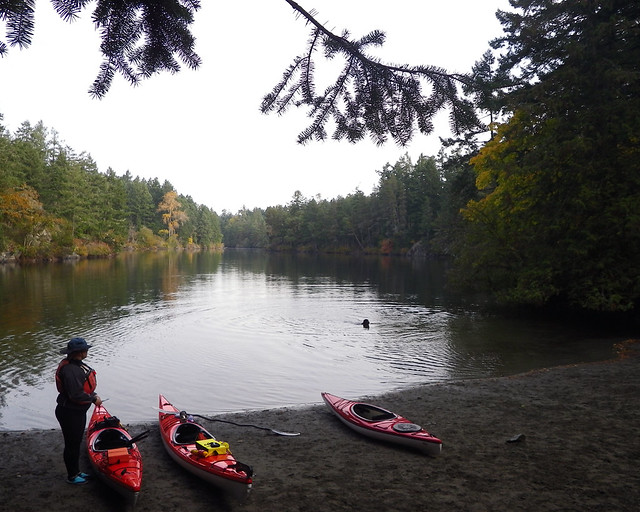
Even though it was a brisk 1 degree as we headed out in the morning, the sun was occasionally poking through the clouds and the cool air certainly woke us up.
Our friend Alison is back in town for a visit. She's been post some great paddle reports of her kayaking adventures in Montreal, but she's here in town for a few days visiting her kayak and giving it a little workout.
Unfortunately, Alison suddenly realized that's she'd forgotten to renew her driver's license before visiting, limiting her options for moving her kayak to put ins. And with Paula limited to commando kayaking on public transit today, a tense two-hour negotiating session ended with the decision to paddle Thetis Lake today. (If David Stern needs help with the NBA lockout, tell him to give us a call. After this, we can negotiate anything.)
Louise and I put in with Alison....

....and caught up with Paula at a different part of the lake.

Checking my records, I see that this is our first paddle this year at the lake. How the heck did that happen?
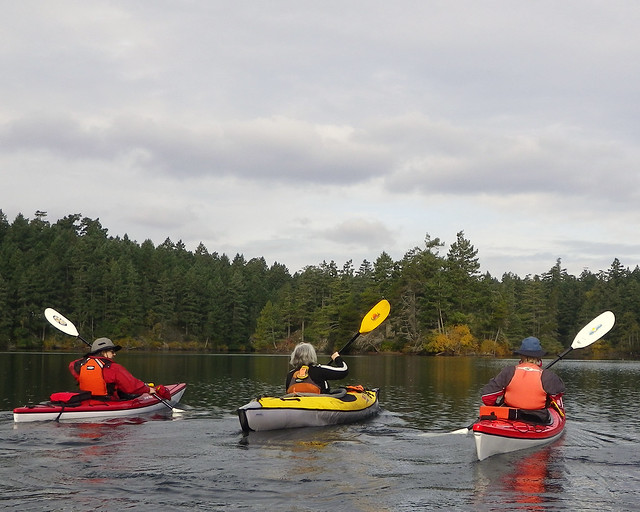
Not only is this a great place to paddle, but it's a great place to do some rescue and paddle practice, but no one felt like doing that today. That water was cold!
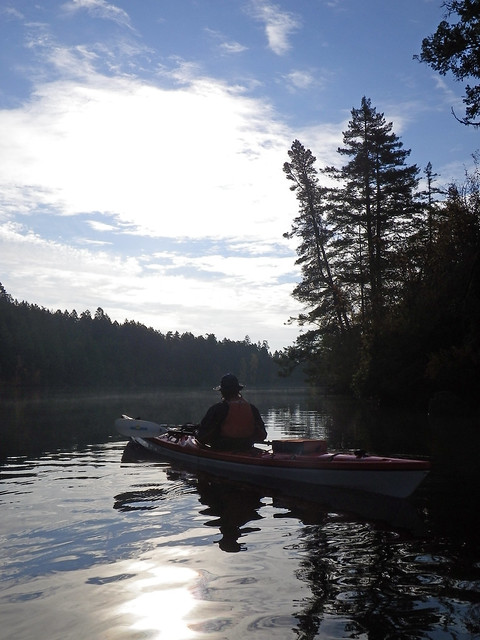
So we spent a couple of hours meandering around the lake....
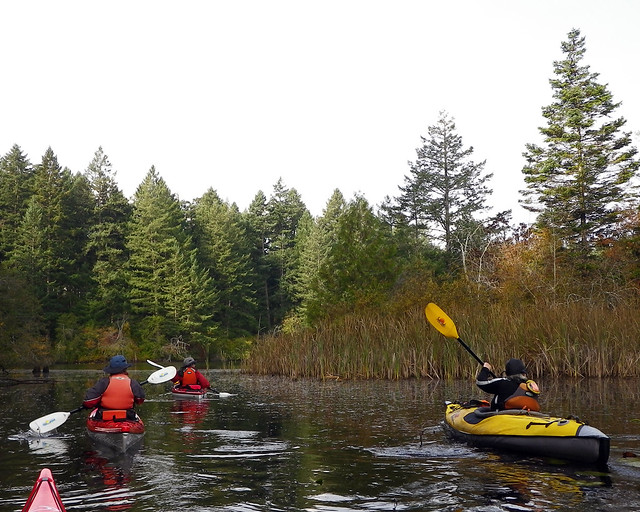
...and then spent a couple of hours warming up afterwards!
But before we could imbibe some warm beverages, we passed a bluff on the shore where a photographer took some snaps of us. We bumped into him later in the parking lot and he graciously emailed us the photos. Thanks for these pictures, Erik!
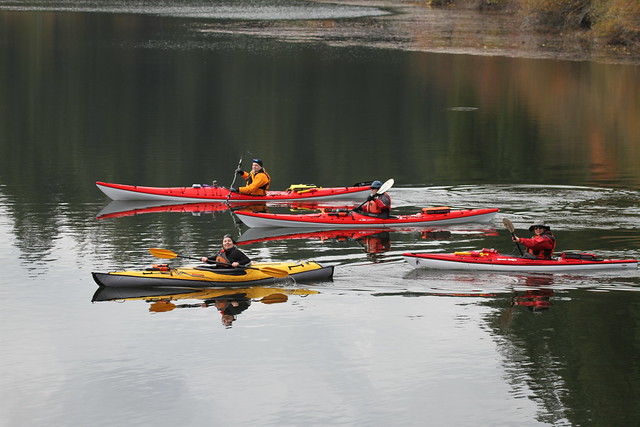

Trip Length: 7.55 km
YTD: 214.59 km
More pictures are here.

BigWaveDave.ca Supports Community Member
Click on the piratical image in the upper left-hand corner of the homepage for BigWaveDave to learn more about the Russian Dood and his story. The forum has begun collecting donations for the BC Cancer Foundation in his name. There will be a draw much like a raffle, but ya get only one ticket no matter how big the donation, eh? The donated prizes include art, jackets, a GoPro helmet cam and weekends at two of the nicest resorts on Vancouver Island.
Solidarity for the Russian Dood and all people being treated for brain cancer, including a relative of one of the Kayak Yak paddle group.
Saturday, November 05, 2011
Debris
The good news is that it won't hit the coast until 2014.
Friday, November 04, 2011
The Dangerous River
The first example is small and merely personal. The D.R. was a terrific read when I was a child, and Prime Minister Eliot Trudeau was guided on the Nahanni River in 1972. In my teens I read the book again as I learned to use a canoe and kayak. The memory of Patterson's journey served me well when a writing assignment came my way years later, to do a biography of Will Hobbs, writer of many young adult adventure novels. One of Hobbs's most successful novels was The Far North, set on the Nahanni River. I was glad to know that when writing the novel, Hobbs read the D.R., but drew on his own experiences paddling the Nahanni with his wife. So, I mused, Hobbs's research included a book I knew well. That helped me understand how Hobbs struggled to compose his novel while he was in the field. He was only able to write the book when he was at home, thinking about the trip. That reminded me of Patterson at his home near Sidney BC in 1953, writing the D.R. more than twenty years after the events recorded in his journal. And there I was, at my isolated home north of Edmonton, writing about the process of writing about a river journey. Very circular.
 The second example is larger and more public. It came this fall when I was reading a review by Richard C. Davis of David Finch`s biography RM Patterson: a life of great adventure. Immediately afterward, I found a review by Paul Huebener of Nahanni Journals: R.M. Patterson's 1927-1929 Journals, which was edited by Richard C. Davis. At this point, I was happy to find that I'd learned a little about Richard C. Davis and what makes him a Patterson scholar.
The second example is larger and more public. It came this fall when I was reading a review by Richard C. Davis of David Finch`s biography RM Patterson: a life of great adventure. Immediately afterward, I found a review by Paul Huebener of Nahanni Journals: R.M. Patterson's 1927-1929 Journals, which was edited by Richard C. Davis. At this point, I was happy to find that I'd learned a little about Richard C. Davis and what makes him a Patterson scholar.For one thing, reading these reviews showed me that Davis is aware of the appeal that Patterson as an author. "Patterson was able to make bold and adventurous choices about how he lived because he enjoyed the privileges of wealth," Davis observes that he read early in Finch's biography, adding that "a personality that can be as comfortable among the refined audience of a London opera house as it is with poorly educated trappers has an appeal of its own."
For another thing, I'd learned a little about how Patterson's journals were edited by Davis. There`s a world of difference between the journals that Patterson kept during his travels, which were addressed to his mother, and the creative nonfiction work The Dangerous River that he wrote based on this material. "The journals reveal certain elements of The Dangerous River to be fabrications," notes reviewer Huebener. "Davis' editorial choices in transcribing the unpolished journal entries are conscientious but unobtrusive." Those are two qualities that I value in an editor. As well, I value the third thing I learned about Davis: he is perceptive in what comments to make about another writer's work. Davis noted in his review of Finch's biography that "Finch speculates, and he is likely correct, that as Patterson matured, 'he rewrote the past to reflect the kind of person he would have liked to have been that summer of 1927' (p. 96)."
So what kind of person would Patterson have liked to have been when he was on the Nahanni? Clearly, Patterson the writer wanted to present himself as a capable man, confident that he was a peer of the capable people who had survived this wilderness. "I dropped off to sleep by the fire, very snug with the warm rocks of the cave around and above me," Patterson wrote on page 154 of the Allen and Unwin edition, "and behind me a long line of copper-coloured hunters reaching far back into the darkness of forgotten centuries."
Patterson also wanted to show himself as a man of good humour. His sense of humour shows most openly in the scene of the pancakes, which he described on page 243 as occurring "rather in the early Chaplin manner." My favourite humourous scene, though is the one near the end of the book on page 234 where Patterson is appalled by his companion Gordon's elaborate cursing of their sled dogs, collectively and severally, "to various hells, including... a certain prideful eastern city."
The scene that works best to show Patterson as a storyteller comes at the beginning of chapter 7, on page 239, when a group of Nahanni Indians visit the cabin Patterson has built with his friend. Here Patterson keeps his good humour harnessed, letting it keep the tone of the scene light but not silly. It's a short scene, in which Patterson represents himself as doing right by his guests, as other First Nations people had done for him in the past. It's a realistic scene, in which real men come to the cabin, drink an abundance of good tea and show their approval by sharing meat as they are leaving. Even so, it has an air of subtle magic. The men who enter the cabin could have walked out of the past instead of out of the surrounding forest. Though the characters speak and act simply during this sequence, it's not a simple scene. It's a metaphor. Patterson wrote this scene to show that he learned about the place and people and was accepted there. The skill of Patterson the writer is subtler here than when he describes Gordon cursing the dogs. In the cursing scene, the writer has plenty of interaction and dialogue to describe in colourful terms. But in the scene of the visiting Nahannis, what is remarkable is how quietly and calmly the little sequence is told. There is almost no dialogue, and no colourful descriptions of people and movements. This scene is an example of very contained and controlled storytelling without all the hoo-rah of burning pancakes or dogfights.
I will have to linger over a copy of Nahanni Journals and see if there is a journal entry corresponding to the Nahannis visiting scene. As a writer, I could learn a lot from comparing the journal notes with the crafted scene. Huebener comments that "The journal entries themselves, which Patterson accurately admits 'are all much the same - got up, travelled & went to bed,' are nevertheless intriguing in terms of the literary construction of wilderness travel experience." That`s an interesting turn of phrase – literary construction of wilderness travel experience. The writing of one`s wilderness travel experience is not merely a documentary recording all the facts, momentous or trivial, but a literary construction of the story the writer means to tell out of all that raw data experienced during travel in the wilderness. Sometimes the story comes full circle.
Wednesday, November 02, 2011
Sea Kayak with Gordon Brown Volume 2
The expedition portion takes us to the islands of St. Kilda, a small group of islands forty miles of the coast of northern Scotland. Here, Gordon and his group tour an amazing group of islands and stunning stacks, caves and channels. It’s a stunningly beautiful area, and clearly made to be explored by kayaks.
The lesson portion demonstrates rescue techniques, both solo and assisted, as well as towing techniques and even a few balance exercises, demonstrated in both calm and rough waters. These lessons are excellently presented and easy to follow (although it must be said that Brown’s brogue occasionally left some in our viewing group asking the others “what did he say?” I didn’t have that issue. Your mileage may vary.) The towing lessons were full of ideas that we’re eager to try next time we have a practice session, and the importance of practicing is brought home by a couple of unplanned tip-overs and tows that occured during filming sessions which necessitated some real assisted rescues and tows.
If you enjoyed Volume 1, you’ll love this. It’s a terrific display of safety measures that ought to be seen by kayakers of all abilities.
Tuesday, November 01, 2011
Linkapalooza
-- Sometimes your adventure just doesn't go as planned. Form the Globe and Mail, here's the story of a fellow who embarks on his dream kayaking expedition, a three-week solo paddle down the West Coast of Vancouver Island. Unfortunately, his dream trip lasted just over an hour. Click here to check it out....and here to read his follow-up story.
-- There's a line from an old Rush song: "Sadder still to watch it die than never to have known it." When I had my bicycle accident almost five years ago, I was heart-broken thinking that I may have to give up this wonderful sport that I'd only just discovered. Luckily for me I was able to continue, but what would it be like to suffer an accident that caused your kayaking skills to quickly wane over a summer?
-- Ever wonder how fish communicate with each other? Turns out it might be by farting.
No, really.
According to an article from NatGeo, "This intriguing idea comes from scientists who discovered that herring create a mysterious underwater noise by farting. Researchers suspect herring hear the bubbles as they’re expelled, helping the fish form protective shoals at night. It’s the first ever study to suggest fish communicate by breaking wind."
-- The Hurricane Riders were riding their kayaks on the Skook recently. Check out their latest video below:
-- The Dash Point Pirate has an interview with Phoxx Ecks who earlier this year spent a month kayaking the northern coast of Vancouver Island with a skin-on-frame kayak, and no gear -- no tent, no sleeping bag, no PFD, and no food or water either -- on a "primitive expedition." Here's the trailer for the interview:
-- And this clip? Well, this is just plain cool:









